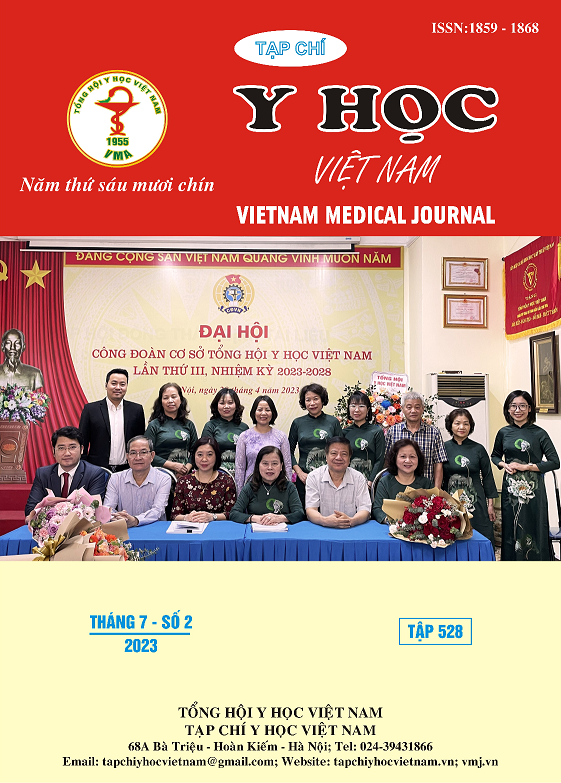EFFECTIVE TREATMENT OF PERIODONTITIS IN PATIENTS WITH TYPE 2 DIABETES WITH DIODE LASER
Main Article Content
Abstract
Background: To describe clinical and subclinical characteristics of periodontitis in patients with type 2 diabetes. To evaluate the effectiveness of diode laser treatment of periodontitis in patients with type 2 diabetes. Materials and methods: Study single-blind randomized clinical intervention (half-mouth design) on patients diagnosed with periodontitis, having type 2 diabetes, coming to China for examination and treatment. Chau Thanh district Health Center, Hau Giang province. Results: Time to detect diabetes: < 5 years: 36.4%; 5 – 10 years: 50%; > 10 years: 13.6%. HbA1c: Well controlled (< 6.5%): 9.5%, Well controlled (6.5% - 7.5%): 47.6%, Poorly controlled (> 7.5%): 27 ,0% (p<0.05). The proportion of patients with periodontitis was found mainly in the poor glucose control group: 72.7% (HbA1c > 7.5%) (p<0.05). Gum bleeding index: Medium (PBI: 1.0 - 3.0): 77.8%; Severe (PBI: > 3.0): 22.2% (p < 0.05). Plaque index (PlI): Mild (PlI < 1.0): 12.7%; Moderate (PlI :1.0 – 1.9): 14.3%, Severe (PlI ≥ 2.0): 73.0%. The average index of periodontitis at 1 months, and 3 months after treatment was lower than before treatment in both groups (p<0.05). The increase in periodontitis index was higher in the control group than in the experimental group (p<0.05). After treatment, over time, the proportion of patients with moderate GI decreased sharply in both groups and changed to mild (p<0.05). The proportion of patients with GI from moderate to mild in the experimental group was higher than in the control group (p < 0.05). Conclusion: Research has demonstrated that the dental diode laser, when used as an adjunct to pocket curettage and root surfacing in the treatment of chronic periodontitis, results in markedly improved clinical numbers (PLI, GI, BOP, PD, and CAL) in the experimental group compared with the control group.
Article Details
Keywords
Periodontitis, type 2 diabetes, HbA1c.
References
2. Hoàng Ái Kiên (2014), Liên quan giữa tình trạng nha chu và bệnh đái tháo đường type 2, Luận văn thạc sỹ y học, Đại học Y Dược thành phố Hồ Chí Minh.
3. Phạm Thúy Mai (2002), Nhận xét sự phục hồi bám dính sau nạo túi lợi trong điều trị bệnh viêm quanh răng, Luận văn Thạc sĩ Y học, Trường Đại học Y Hà Nội.
4. Nguyễn Bích Vân, Huỳnh Anh Lan (2019), Cập nhật về mối liên quan giữa bệnh nha chu và bệnh toàn thân, Thời sự Y học 9/2019, tr. 7.
5. American Academy of Periodontology (2015) American Academy of Periodontology Task Force Report on the Update to the 1999 Classification of Periodontal Diseases and Condition. Periodontal journal, 86(7) pp. 835-838.
6. Chandra S, Shashikumar P (2019) Diode laser- A novel therapeutic approach in the treatment of chronic periodontitis in type 2 diabetes mellitus patients: A prospective randomized controlled clinical trial. J Laser Med Sci, 10(1): 56-63.
7. Chávarry N, Vettore M, et al (2009), The Relationship Between Diabetes Mellitus and Destructive Periodontal Disease: A Meta-Analysis. Oral Health Prev Dent, 7 pp. 107-127.
8. Emrah Kocak, Mehmet Saglam, et al (2016) Nonsurgical periodontal therapy with/without diode laser modulates metabolic control of type 2 diabetics with periodontitis: randomized clinical trial. Laser Med Sci, 31(2): 343-353.
9. Kim E.-K., Lee S.G., Choi Y.-H., et al (2013) Association between diabetes-related factors and clinical periodontal parameters in type-2 diabetes mellitus. BMC Oral Health, 13 (1) pp. 1.


